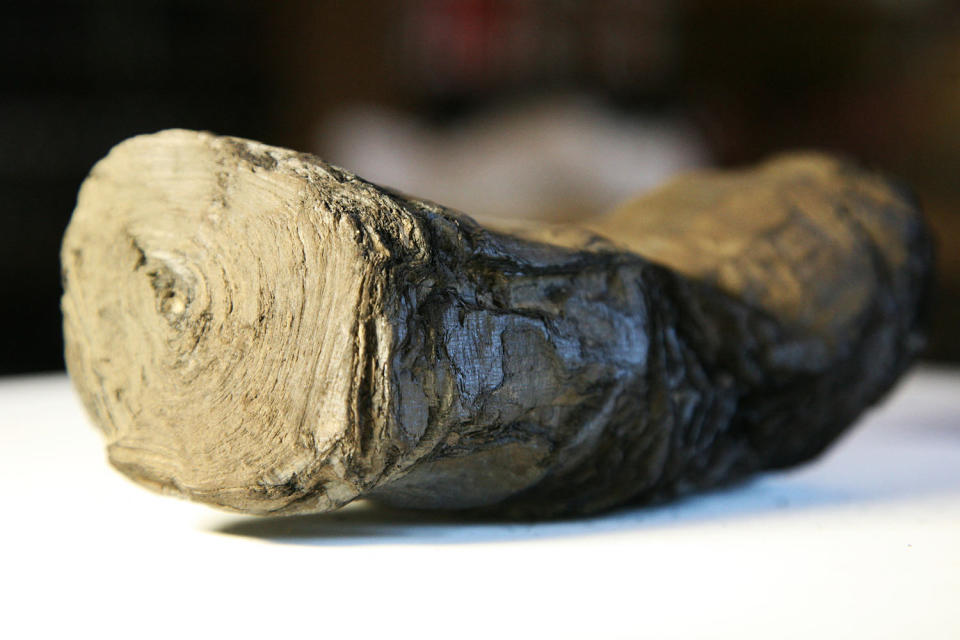Secrets of ancient Herculaneum scroll deciphered by AI
- Oops!Something went wrong.Please try again later.
ROME — Buried in ash after Mount Vesuvius’ cataclysmic eruption in A.D. 79, hundreds of papyrus scrolls have kept their secrets hidden for centuries. But archeologists have now been able to decipher some of the ancient text with the help of artificial intelligence.
Discovered in the ruins of a villa thought to have been owned by Julius Caesar’s father-in-law, Lucius Calpurnius Piso Caesoninus, the Herculaneum papyri are a collection of around 1,000 scrolls that were carbonized during the eruption, along with thousands of other relics.
Found by a farmworker in the 18th century, they are named after the place where they were buried, Herculaneum — an ancient Roman town to the south of Pompeii that was also destroyed by the blast.
Previous attempts to unlock their secrets have failed because most of the scrolls were turned into carbonized ash and broke into pieces. However, a number of them were painstakingly unrolled by a monk over several decades and found to contain philosophical texts written in Greek.
“Until now, the only way we have had to read what’s inside the Herculaneum scrolls is to put together the thousands of pieces of the ones that crumbled apart,” Richard Janko, a distinguished professor of classical studies at the University of Michigan, told NBC News on Thursday.

“It’s like putting together a mosaic, and there’s not many people willing to do it,” he added. “So it may take 500 years to decipher their content. With this technique, hopefully, it should be much easier, and quicker.”
The breakthrough came after a global competition was launched to accelerate the reading of the texts. The Vesuvius Challenge offered $1 million in prizes to anyone who could solve the problem and find a way to read the remaining 270 closed scrolls, most of which are preserved in a library in Naples, which is around 8 miles west of Herculaneum.
It was launched by a team at the University of Kentucky led by professor Brent Seales, who released software and thousands of 3D X-ray images of three papyrus fragments and two rolled-up scrolls, in the hope that global research groups would take up the challenge.
Seales’ team had already pioneered a way to “virtually unwrap” an ancient scroll from Israel using X-ray tomography and computer vision. But even that was not enough to read the barely visible ink on the ancient documents from Herculaneum.
“The chemistry of the ink from the ancient world is different than the chemistry from medieval times. It’s largely invisible to the naked eye even when caught by the X-ray,” he said. “However, we know the tomography captures information about the ink.”
“In 2019, we did come up with a solution based on artificial intelligence that allowed us to ‘see’ the ink, but it needed a lot of data, and we had a small team. So we launched the challenge to scale up our processes and accelerate the work,” he added.
A total of 18 teams entered the competition, and the best results were sent to an international team of papyrologists, who assessed each entry for legibility and worked to transcribe the texts.
In the end, the judges, who included Janko, decided that a team of three students — Luke Farritor from the U.S., Youssef Nader from Egypt, and Julian Schilliger from Switzerland — should share the $700,000 grand prize.
The trio were able to read 2,000 letters from the scroll after training machine-learning algorithms on the scans. After creating a 3D scan of the text using a CT scan, the scroll was then separated into segments. A machine learning model — an application of AI — then detected the inked regions, allowing them to decipher the text.
After the winners were announced earlier this week, one of the competition's sponsors, Nat Friedman, wrote on the social media platform X that they had been able to read “new text from the ancient world that has never been seen before,” from 15 columns at the very end of the first scroll.
“The author — probably Epicurean philosopher Philodemus — writes here about music, food, and how to enjoy life’s pleasures,” he said. In the closing section, the author throws shade at unnamed ideological adversaries — perhaps the stoics? — who “have nothing to say about pleasure, either in general or in particular.”
Giancarlo del Mastro, a professor of papyrology at Naples’ University Campania Luigi Vanvitelli, called the technique “revolutionary.”
“We were astonished,” said del Mastro, who also helped to judge the Vesuvius Challenge. “We worked literally day and night to interpret them, but what I am even more excited about is that using this method we can now reveal what has been hidden in the papyrus for almost 2,000 years.”
This article was originally published on NBCNews.com

